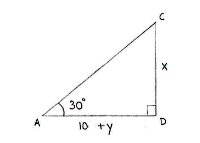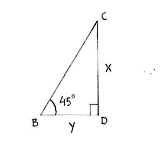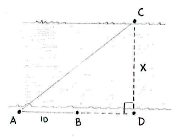Lösung 4.2:7
Aus Online Mathematik Brückenkurs 1
(Unterschied zwischen Versionen)
K (hat „Solution 4.2:7“ nach „Lösung 4.2:7“ verschoben: Robot: moved page) |
|||
| Zeile 1: | Zeile 1: | ||
| - | + | Wenn wir die Gerade AB zu einen Punkt D verlängern, der gegenüber von C liegt. bekommen wir ein rechtwinkliges Dreieck wie im unteren Bild, wo der Abstand ''x'' erfragt ist. | |
[[Image:4_2_7_1.gif|center]] | [[Image:4_2_7_1.gif|center]] | ||
| - | + | Wir betrachten die zwei Dreiecke ACD und BCD, und den Tangens für deren Winkeln 30° und 45° | |
{| align="center" | {| align="center" | ||
| Zeile 15: | Zeile 15: | ||
|} | |} | ||
| - | + | ,wo ''y'' der Abstand zwischen B und D ist. | |
| - | + | Die zweite Gleichung gibt <math>y=x</math> und dies in der ersten Gleichung gibt | |
{{Abgesetzte Formel||<math>x = (10+x)\frac{1}{\sqrt{3}}\,\textrm{.}</math>}} | {{Abgesetzte Formel||<math>x = (10+x)\frac{1}{\sqrt{3}}\,\textrm{.}</math>}} | ||
| - | + | Wir multiplizieren beide Seiten mit <math>\sqrt{3}</math>, und erhalten | |
{{Abgesetzte Formel||<math>\sqrt{3}x=10+x</math>}} | {{Abgesetzte Formel||<math>\sqrt{3}x=10+x</math>}} | ||
| - | + | Wir sammeln alle ''x''-Terme auf einer Seite, | |
{{Abgesetzte Formel||<math>(\sqrt{3}-1)x = 10\,\textrm{.}</math>}} | {{Abgesetzte Formel||<math>(\sqrt{3}-1)x = 10\,\textrm{.}</math>}} | ||
| - | + | und also haben wir | |
{{Abgesetzte Formel||<math>x = \frac{10}{\sqrt{3}-1}\ \text{m}\approx 13\textrm{.}6\ \text{m.}</math>}} | {{Abgesetzte Formel||<math>x = \frac{10}{\sqrt{3}-1}\ \text{m}\approx 13\textrm{.}6\ \text{m.}</math>}} | ||
Version vom 16:24, 4. Apr. 2009
Wenn wir die Gerade AB zu einen Punkt D verlängern, der gegenüber von C liegt. bekommen wir ein rechtwinkliges Dreieck wie im unteren Bild, wo der Abstand x erfragt ist.
Wir betrachten die zwei Dreiecke ACD und BCD, und den Tangens für deren Winkeln 30° und 45°

| 
| |
| \displaystyle \begin{align} x &= (10+y)\tan 30^{\circ}\\[5pt] &= (10+y)\frac{1}{\sqrt{3}}\end{align} | \displaystyle \begin{align} x &= y\cdot\tan 45^{\circ}\\[5pt] &= y\cdot 1\end{align} |
,wo y der Abstand zwischen B und D ist.
Die zweite Gleichung gibt \displaystyle y=x und dies in der ersten Gleichung gibt
| \displaystyle x = (10+x)\frac{1}{\sqrt{3}}\,\textrm{.} |
Wir multiplizieren beide Seiten mit \displaystyle \sqrt{3}, und erhalten
| \displaystyle \sqrt{3}x=10+x |
Wir sammeln alle x-Terme auf einer Seite,
| \displaystyle (\sqrt{3}-1)x = 10\,\textrm{.} |
und also haben wir
| \displaystyle x = \frac{10}{\sqrt{3}-1}\ \text{m}\approx 13\textrm{.}6\ \text{m.} |

